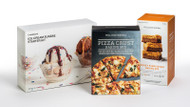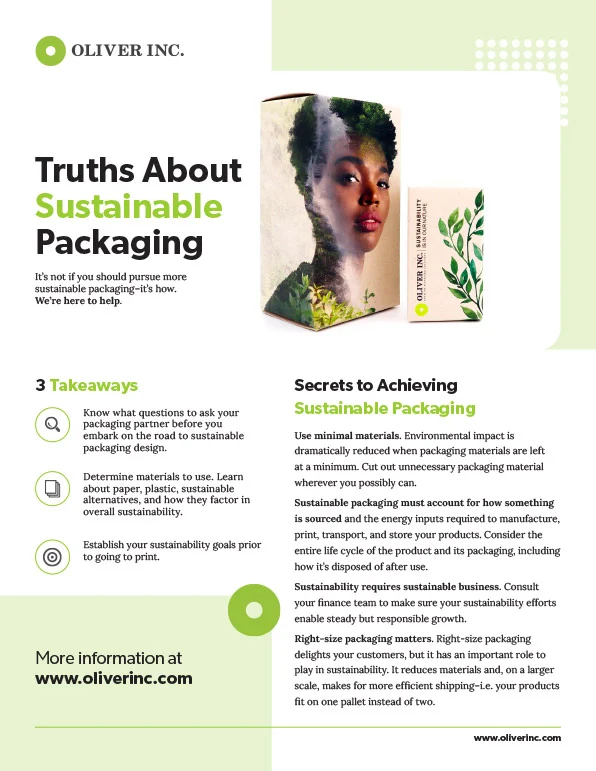Designing Eye-Catching Food Packaging
Posted by Oliver Inc. on 10th Mar 2022
Unless you can attract their attention with compelling packaging, it’s difficult getting consumers to try your tasty food contained inside.
Of the many things to consider with food packaging, attractive visuals is obviously near the top of the list.
Here are several aspects of food packaging you’ll want to examine before you begin conversations with potential printing and packaging partners.
Packaging Material Considerations
To get that eye-grabbing effect, you’ll want to start with the right food packaging material that accounts for food safety, protection, and necessary structural elements.
Food Safety
Naturally, you can’t go with just any packaging material. It has to be food safe. Expensive recalls can sour your product line and flatten your brand reputation.
To keep your food products safe, look for a packaging manufacturer that complies with the Global Food Safety Initiative (GFSI). A manufacturer is certified to handle food and beverage products if they have earned the Safety Quality Food (SQF) certification, recognition that a company meets industry, consumer, and regulatory requirements for all aspects of the supply chain.
Design Elements
Your particular goals will determine which materials and designs are most appropriate. For instance, barrier coatings between packaging and the food can preserve the substrate while maintaining the integrity of food ingredients.
Windowing, for example, provides additional protection while serving a few other design purposes. By making your food visible, you’re likely to attract consumer attention, especially if the primary packaging or food itself has an appealing look. Be sure all packaging materials and food combine in a way that accounts for condensation, temperature changes, and breathability.
Protection
Don’t overlook the protection your food products will require for transportation and handling. What will happen if a consumer drops the product off a high shelf? How much pressure can its structure withstand when products are stacked together? How abrasion resistant do you want your packaging to be?
Your structural design and materials should combine to avoid spills, breakages, or tears that would undermine food products or the visual designs meant to attract consumer attention.
Now that you’ve considered some practical concerns, which decorative effects will help your food packaging become more eye-catching?
Eye-Catching Design & Decorative Effects
Many options abound when it comes to specialty inks, laminates, coatings, finishes, and packaging structures. Here are just a few of them.
Hot foil stamping involves applying foil to a substrate using pressure-heating technology. Most commonly in silver and gold, these metallic hues can be employed with almost any color. Hot foil stamping can help a logo or particular visual element stand out when contrasted with a dark or minimalist background. Its shiny, rare look lends well to luxury and high-end food brands that want to signal premium quality.
Cold foil is a similar process, but instead utilizes UV light to apply foil to a material. You can overprint and create a dynamic range of colors, or customize foils by applying CMYK or PMS colors.
Specialty laminates and coatings don’t only give substrates additional protection and durability—something vital for food packaging—but also deliver extra shine. You can apply them to an entire folding carton, or select areas to emphasize visual features. Matte finishes draw the eyes by reflecting light off the surface.
Embossing and debossing create new dimensions for food packaging. By raising or lowering a visual element in a substrate—envision a bumpy, tactile text—you encourage more interaction with your product. People want to touch the embossing or debossing, which leaves a lasting impression because they’re engaging an additional sense.
This tactile feature can also enhance the unboxing experience.
Shelf-ready packaging is another valuable part of the food packaging repertoire. Designed to streamline stocking and storage, shelf-ready packaging can help your product stand out among other brands using more basic or generic packaging structures.
Connected packaging invites consumers into a more immersive experience with your food product. Intended to bridge physical experiences to digital ones, such as websites, videos, or other online content, connected packaging can grab attention with a simple hashtag or QR code scanned with a mobile device. The extra effort you put into curating digital experiences will help distinguish you from other brands, and attract consumers.
Keeping Sustainability in Mind
Food brands have historically relied on plastic packaging because of its durability. However, a rising demand for more sustainable alternatives is causing brands to reconsider plastic—or at least encouraging them to reduce, reuse, and recycle whenever possible.
More and more consumers expect brands to use sustainable packaging, including alternatives substrates, less packaging material, and employment of shorter supply chains. Put simply, sustainable packaging is about using only as much material as needed to protect and ship your products, while reducing your carbon footprint and ecological impacts.
When using paper, be sure it is sourced from responsibly managed forests. Certifications from the nonprofit Forest Stewardship Council (FSC), Sustainable Forest Initiative (SFI), or Programme for the Endorsement of Forest Certification (PEFC) are reliable harbingers for sustainably sourced materials. Verify whether your manufacturer has these certifications before partnering with them.
Additionally, employing sustainable alternatives such as hemp, sugarcane bagasse, or cotton, among others, demonstrates to consumers you’re serious about environmental stewardship. Post-consumer recycled paper is another available avenue to consider.
Sustainable food packaging is likely only to grow in importance, so keep it in mind as you contemplate which visual elements of packaging design will really appeal to consumers.
Each of these food packaging design considerations should inform questions to ask your food packaging manufacturer. When you work with an experienced packaging partner, you can anticipate an expert capable of accounting your primary packaging goals, helping your products shine on the shelf and elevating your brand.






